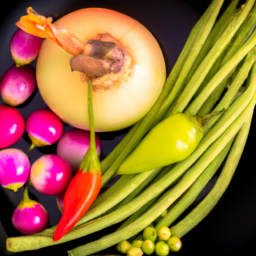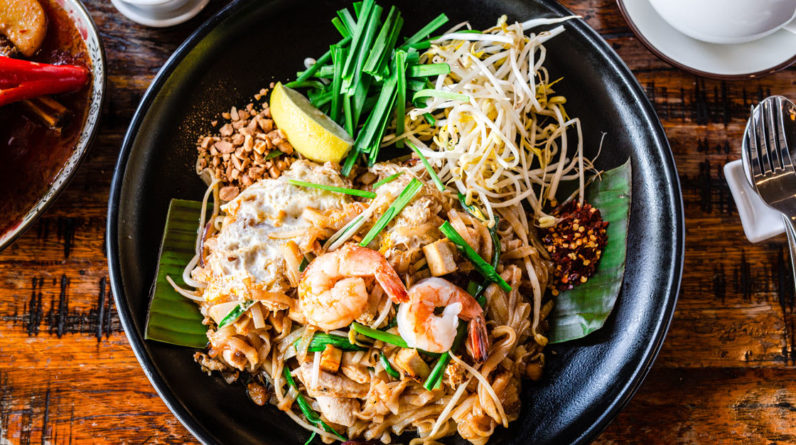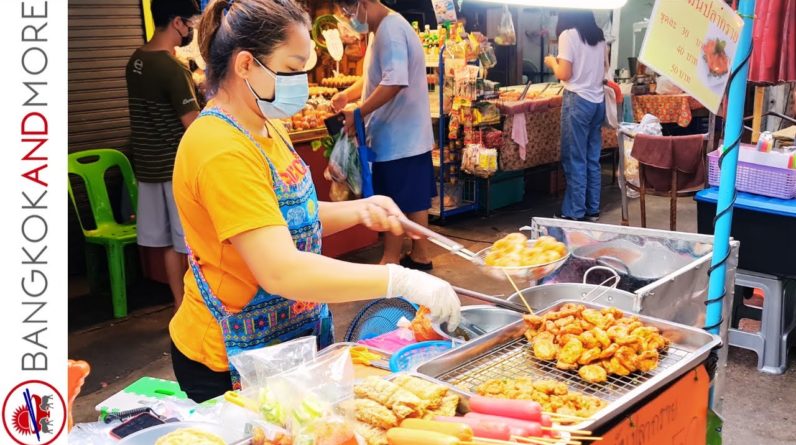
Thailand is a country known for its vibrant and diverse cuisine, which is a reflection of the country’s rich cultural heritage and flavors. From tangy, spicy curries to fragrant noodle dishes, the food of Thailand is a delightful fusion of bold flavors and aromatic spices. Thai cuisine is not only delicious but also visually appealing, with colorful ingredients and artful presentations. In this article, you’ll get a taste of the mouthwatering dishes that symbolize the essence of Thai cuisine, offering a glimpse into the culinary wonders this Southeast Asian nation has to offer. Whether you’re a food enthusiast or simply curious about exploring new flavors, prepare yourself for a culinary journey that will leave you craving more.
History of Thai Cuisine
Thai cuisine is known for its vibrant flavors, aromatic herbs, and the perfect balance of sweet, sour, salty, and spicy. The history of Thai cuisine is a tale of cultural exchange and culinary evolution. Over centuries, Thai cuisine has been influenced by the cuisines of neighboring countries, introducing new ingredients and flavors to create a unique culinary identity. The development and evolution of dishes have also been shaped by regional variations, each offering its own distinct flavors and techniques. Let’s dive deeper into the fascinating history of Thai cuisine.
Influences from neighboring countries
Thai cuisine has been heavily influenced by the neighboring countries of China, India, Laos, and Cambodia. These influences can be seen in the types of ingredients used, cooking techniques, and flavor profiles. Chinese influence brought the use of stir-frying and noodles, Indian influence introduced the use of spices such as turmeric and cumin, and Cambodian and Laotian influences contributed to the use of fresh herbs and fermented flavors. Thai cuisine skillfully combines these diverse influences to create a harmonious and flavorful culinary experience.
Introduction of new ingredients
Another significant aspect of the history of Thai cuisine is the introduction of new ingredients. Traders from the Middle East brought spices like cinnamon, cloves, and star anise, which are now commonly used in Thai curries. The Portuguese introduced chilies, which have become a staple in Thai cooking. The fusion of these foreign ingredients with local Thai ingredients created a unique flavor profile that distinguishes Thai cuisine from other Southeast Asian cuisines.
Development and evolution of dishes
Thai cuisine has continuously evolved and adapted throughout history. The most notable development is the shift from a simple peasant cuisine to a more refined and complex culinary tradition. In the past, Thai cuisine consisted mainly of simple dishes prepared with locally available ingredients. However, in the royal courts of ancient Siam, extravagant feasts were prepared, incorporating a wide array of flavors and ingredients. Over time, these royal dishes made their way into the commoners’ kitchens, leading to the expansion and diversification of Thai culinary traditions.
Regional Varieties
The regional varieties of Thai cuisine offer an exciting exploration of flavors and culinary traditions. Thailand can be divided into four main culinary regions: Northern, Central, Southern, and Northeastern (Isan) Thai Cuisine. Each region has its own unique ingredients, cooking techniques, and flavor profiles.
Northern Thai Cuisine
Northern Thai cuisine, also known as Lanna cuisine, is characterized by its mild and subtle flavors. Influenced by neighboring Myanmar and China, the cuisine features ingredients such as lemongrass, galangal, and turmeric. Khao Soi, a popular dish from this region, is a rich and creamy curry noodle soup with tender pieces of meat or tofu.
Central Thai Cuisine
Central Thai cuisine is the most widely recognized and popular in Thailand. It is known for its bold and vibrant flavors, featuring a combination of sweet, sour, and spicy elements. Pad Thai, one of the most famous Thai dishes, originated in Central Thailand. The cuisine also emphasizes the use of aromatic herbs like Thai basil and cilantro.
Southern Thai Cuisine
Southern Thai cuisine is characterized by its fiery and pungent flavors. Influenced by the neighboring Malay Peninsula, the cuisine incorporates a diverse range of spices and seafood. A popular dish from this region is Gaeng Tai Pla, a spicy and fragrant fish curry made with turmeric, shrimp paste, and chili.
Northeastern (Isan) Thai Cuisine
Northeastern Thai cuisine, also known as Isan cuisine, has its roots in the rural farming communities of Thailand. It features bold and robust flavors, often prepared with simple and humble ingredients. Som Tum, a spicy green papaya salad, is a staple dish in Isan cuisine. The cuisine also utilizes sticky rice as a dietary staple.
Key Ingredients
Thai cuisine is known for its distinct flavors, achieved through the use of key ingredients that are the backbone of traditional Thai cooking.
Rice
Rice is the staple food of Thailand, and it is consumed with almost every meal. Sticky rice, known as “khao niao,” is favored in the northeastern region, while jasmine rice, known as “khao hom mali,” is popular in other parts of the country. Rice is not only a main dish, but it is also used to make noodles, snacks, and desserts.
Coconut milk
Coconut milk is a crucial ingredient in Thai cuisine, adding richness and creaminess to curries, soups, and desserts. It is made by grating the white flesh of mature coconuts and squeezing out the liquid. The thick and creamy milk is used in dishes such as green curry and mango sticky rice.
Chili peppers
Chili peppers are an essential ingredient in Thai cuisine, adding heat and spice to dishes. Thai chilies come in various sizes and levels of spiciness. They are used both in fresh form and in paste form. The spiciness of Thai food can be adjusted according to individual preferences.
Fish sauce
Fish sauce, known as “nam pla,” is a pungent and savory condiment made from fermented fish. It is used as a seasoning and flavor enhancer in many Thai dishes, adding a distinctive umami flavor. Fish sauce is a key component in Thai curries, stir-fries, and dipping sauces.
Galangal
Galangal is a root native to Southeast Asia, similar to ginger but with a more citrusy and peppery flavor. It is a common ingredient in Thai curries and soups, adding a unique aroma and depth of flavor. Galangal is sliced or pounded and often used in combination with other aromatic herbs.
Lemongrass
Lemongrass is a herb with a distinct lemony flavor, commonly used in Thai cuisine. It adds a refreshing and citrusy note to dishes and is a key ingredient in soups, curries, and stir-fries. Lemongrass is usually lightly pounded or chopped before being added to dishes to release its flavor.
Kaffir lime leaves
Kaffir lime leaves are prized for their aromatic and citrusy flavor, often used in Thai soups, curries, and stir-fries. They have a unique shape, with a double leaf structure resembling an hourglass. Kaffir lime leaves add a subtle tang and fragrance to dishes, enhancing their overall flavor profile.
Popular Dishes
Thai cuisine offers a wide array of delicious dishes that have gained popularity worldwide. These dishes showcase the bold flavors, vibrant colors, and delicate balance of Thai cuisine.
Pad Thai
Pad Thai is arguably the most well-known Thai dish, loved for its perfect blend of sweet, sour, and savory flavors. It is a stir-fried noodle dish made with rice noodles, tofu or shrimp, bean sprouts, and a flavorful sauce. Common toppings include crushed peanuts, lime wedges, and fresh herbs.
Tom Yum Soup
Tom Yum Soup is a hot and sour soup known for its bold and refreshing flavors. It is made with a fragrant broth infused with lemongrass, galangal, kaffir lime leaves, and Thai chilies. The soup is typically filled with shrimp, mushrooms, and other vegetables, creating a harmonious balance of flavors.
Green Curry
Green Curry is a classic Thai dish that is favored for its creamy and aromatic flavors. It is made with a paste consisting of green chilies, lemongrass, galangal, garlic, and various herbs and spices. The curry is cooked with meat or vegetables and finished off with coconut milk to create a rich and flavorful dish.
Som Tum (Papaya Salad)
Som Tum, also known as Papaya Salad, is a refreshing and spicy salad made with shredded green papaya, cherry tomatoes, green beans, peanuts, and a tangy dressing. The dressing typically includes fish sauce, lime juice, palm sugar, and Thai chilies, creating a perfect balance of sweet, sour, and spicy flavors.
Massaman Curry
Massaman Curry is a rich and flavorful curry that has a unique blend of Thai and Indian influences. It features tender chunks of meat, such as beef or chicken, cooked in a velvety curry sauce flavored with spices like cardamom, cinnamon, and cloves. The curry is often garnished with roasted peanuts and potatoes.
Khao Pad (Fried Rice)
Khao Pad, or Fried Rice, is a popular street food dish that is enjoyed by locals and tourists alike. It is made by stir-frying rice with a variety of ingredients such as meat, seafood, vegetables, and eggs. The dish is seasoned with soy sauce, fish sauce, and aromatic herbs, resulting in a flavorful and satisfying meal.
Street Food Culture
The vibrant street food culture of Thailand is a culinary adventure that every traveler must experience. Thai street food is not only delicious but also offers a glimpse into the local way of life.
Vibrant food stalls and night markets
Thai cities come alive with bustling food stalls and night markets, where the sizzling aromas and vibrant flavors of Thai cuisine fill the air. Walking through these lively streets, you will be greeted by various vendors selling an array of street food delights. From sizzling satay skewers and flavorful noodles to sweet and sticky desserts, the options are endless.
Must-try street food dishes
When exploring Thai street food, there are a few must-try dishes that should not be missed. One such dish is Moo Ping, succulent grilled pork skewers marinated in a sweet and savory sauce. Another street food favorite is Gai Tod, crispy fried chicken that is wonderfully seasoned and paired with spicy dipping sauces. For those with a sweet tooth, Roti is a popular option, a crispy and flaky pancake served with a variety of toppings such as condensed milk, bananas, or chocolate.
Exploring the flavors of Thai street food
Thai street food is an adventure for your taste buds, offering an explosion of flavors and unique combinations. From the tangy and spicy flavors of Tom Yum Soup to the rich and silky textures of Pad Thai, each street food dish is a masterpiece in its own right. Exploring the flavors of Thai street food is a sensory journey that allows you to immerse yourself in the rich culinary heritage of Thailand.
Royal Thai Cuisine
Royal Thai cuisine, also known as Palace Cuisine, is a refined and elegant culinary tradition that originated in the royal courts of ancient Siam. It is characterized by its elaborate presentation, intricate flavors, and the use of high-quality ingredients.
History and significance
Royal Thai cuisine has a long and prestigious history, dating back to the Ayutthaya Kingdom in the 14th century. It was originally developed to please the royal court and guests with its exquisite flavors and artistic presentation. Over time, the cuisine has become an integral part of Thailand’s cultural heritage, symbolizing luxury, elegance, and refinement.
Elaborate presentation and intricate flavors
Royal Thai cuisine is known for its elaborate presentation, where dishes are carefully crafted to resemble works of art. The use of vibrant colors, intricate carvings, and delicate garnishes creates a visual feast for the eyes. In addition to the stunning presentation, the flavors of royal Thai cuisine are complex and nuanced. Each dish is meticulously balanced to achieve the perfect harmony of flavors.
Dishes served in royal ceremonies
In royal ceremonies, a selection of dishes from the royal Thai cuisine is served to honor special occasions and guests. These dishes often reflect the cultural and culinary heritage of Thailand, showcasing the skills and expertise of Thai chefs. Some notable dishes served in royal ceremonies include Kaeng Kradang, a fragrant curry made with river prawns, and Khao Chae, a refreshing dish of jasmine rice served with various savory accompaniments.
Vegetarian and Vegan Options
Thai cuisine offers a wide range of vegetarian and vegan options, making it a paradise for plant-based eaters. The use of fresh vegetables, herbs, and spices creates a delightful medley of flavors and textures.
Traditional dishes with plant-based substitutes
Many traditional Thai dishes can be easily adapted to suit vegetarian or vegan diets. For example, green curry can be made using tofu or vegetables instead of meat. Pad Thai can be prepared using soy sauce instead of fish sauce and omitting the shrimp. Som Tum, the spicy green papaya salad, can be made without fish sauce and dried shrimp.
Vegetarian-friendly Thai restaurants
In Thailand, there are numerous vegetarian-friendly restaurants that cater specifically to plant-based eaters. These restaurants serve a variety of vegetarian and vegan dishes, including popular Thai favorites and innovative plant-based creations. They often use plant-based substitutes like tofu, mushrooms, and soy protein to mimic the flavors and textures of traditional meat-based dishes.
Specialty vegan restaurants
For those following a strict vegan diet, there are also specialty vegan restaurants available in Thailand. These establishments offer a wide range of vegan options, using only plant-based ingredients and no animal products or by-products. From vegan versions of Pad Thai to plant-based curries and stir-fries, vegan restaurants in Thailand provide a haven for those seeking delicious and ethical dining options.
Famous Thai Chefs
Thai cuisine has gained global recognition, thanks to the talent and expertise of renowned Thai chefs. These chefs have not only popularized Thai cuisine but also elevated it to new heights, showcasing its diversity and complexity.
David Thompson
David Thompson is an Australian-born chef who is widely regarded as one of the world’s leading experts in Thai cuisine. He has extensively studied and researched traditional Thai cooking techniques, making him a true authority in the field. Thompson’s restaurant, Nahm, located in Bangkok, has received numerous accolades and has been recognized as one of the best Thai restaurants in the world.
Duangporn ‘Bo’ Songvisava
Duangporn ‘Bo’ Songvisava is a highly acclaimed Thai chef and co-owner of the restaurant Bo.Lan in Bangkok. She is known for her commitment to using local and sustainable ingredients, as well as reviving traditional Thai cooking methods. Songvisava has been recognized as the Best Female Chef in Asia and has played a significant role in promoting sustainable and ethical dining practices in the Thai culinary scene.
Ian Kittichai
Ian Kittichai is a Thai chef who has made a name for himself both in Thailand and internationally. He has worked in some of the finest restaurants around the world and has been a judge on popular cooking shows. Kittichai is known for his innovative and modern approach to Thai cuisine, combining traditional flavors with contemporary techniques.
Pim Techamuanvivit
Pim Techamuanvivit is a Thai chef and restaurateur who has gained recognition for her culinary expertise. Her restaurant, Kin Khao, located in San Francisco, showcases the vibrant flavors and regional specialties of Thai cuisine. Techamuanvivit is known for her commitment to using high-quality ingredients and staying true to the authentic flavors of Thai cuisine.
Street Food Safety
While Thai street food is a delightful culinary experience, it is essential to prioritize food safety and hygiene when indulging in street food delights.
Hygiene practices
When selecting a street food vendor, it is important to observe their hygiene practices. Look for stalls that maintain cleanliness, such as regularly washing utensils and using gloves when handling food. Food should be prepared and cooked in clean and well-maintained cooking areas.
Choosing reputable vendors
Opt for street food vendors that have a good reputation and a steady stream of customers. Popular and busy stalls often indicate that the food is both delicious and safe to consume. Locals can also provide recommendations on reputable street food vendors in the area.
Common street food precautions
To minimize the risk of foodborne illnesses, employing certain precautions is advisable. Ensure that the food is cooked thoroughly and served hot to kill any harmful bacteria. It is also recommended to avoid consuming raw or undercooked food, especially when it comes to seafood and meat.
Thai Food and Health
Thai cuisine not only delights the taste buds but also offers various health benefits. The balanced flavors and nutritious ingredients make Thai food a healthy choice when consumed as part of a well-rounded diet.
Balanced flavors and nutritional benefits
One of the key aspects of Thai cuisine is achieving a balanced blend of flavors, including sweet, sour, salty, and spicy elements. This balance not only enhances the taste but also provides a diverse range of nutrients. Thai dishes often incorporate a variety of vegetables, herbs, and spices, which are rich in vitamins, minerals, and antioxidants.
Impact of Thai cuisine on health
The use of aromatic herbs and spices in Thai cuisine not only adds depth of flavor but also provides health benefits. Ingredients like lemongrass, galangal, and chili peppers have been traditionally used for their medicinal properties. Lemongrass, for example, is known for its antibacterial and digestive properties, while chili peppers can boost metabolism and aid in pain relief.
Healthy Thai food alternatives
For those looking for healthier options, Thai cuisine offers plenty of choices. Opting for grilled or steamed dishes instead of deep-fried ones can reduce the intake of unhealthy fats. Salads and stir-fries with generous amounts of vegetables are both nutritious and delicious. Adding extra vegetables to curries and soups can increase the fiber content of the meal and provide additional vitamins and minerals.
In conclusion, Thai cuisine is a rich and diverse culinary tradition that reflects the country’s history, cultural influences, and regional variations. From the influences of neighboring countries to the development of royal cuisine, Thai food tells a captivating story. With an abundance of key ingredients and popular dishes, Thai cuisine offers something for every palate. Whether indulging in street food delights or savoring the intricate flavors of royal Thai cuisine, exploring Thai food is a journey that will ignite your taste buds and leave you craving for more. So, grab your chopsticks or spoon, and embark on a gastronomic adventure through the flavors of Thailand.


